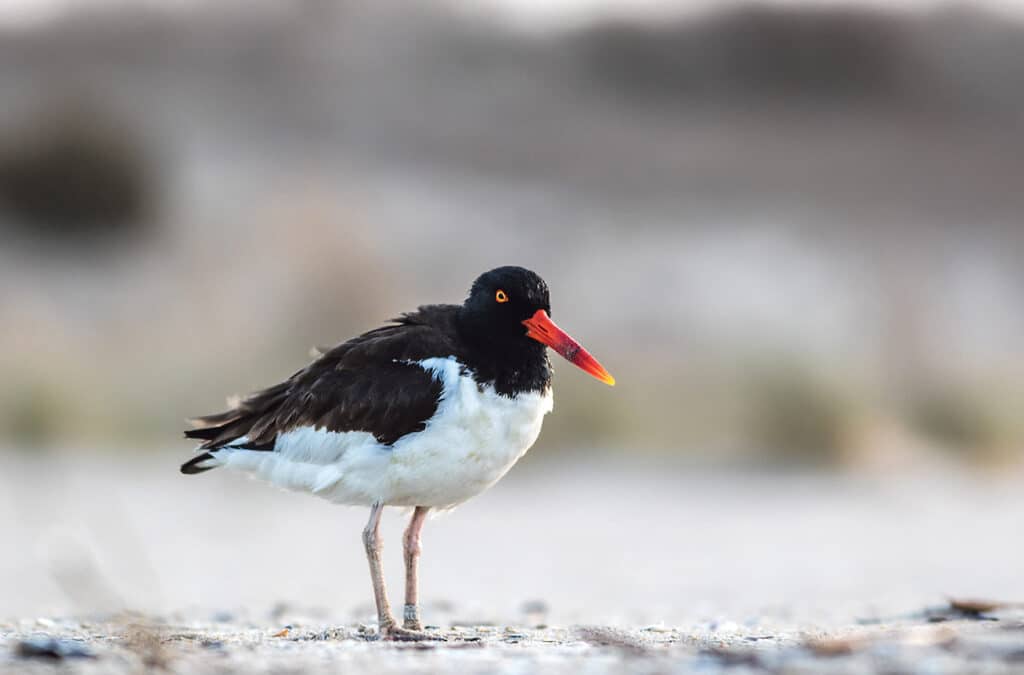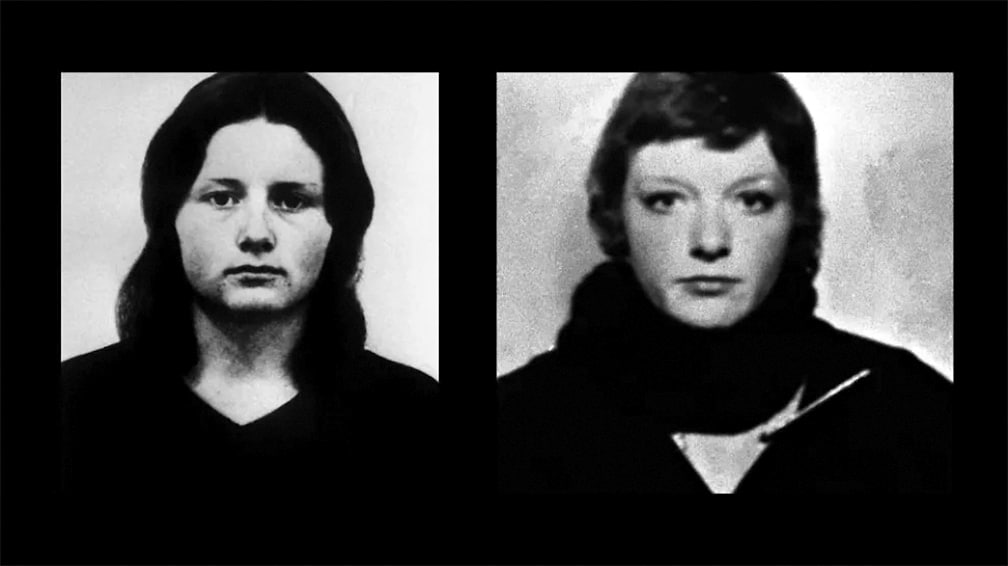
Waders are, for the most part, birds of coastal mudflats, inlets and sandy beaches. Some frequent grassy meadows, remote uplands and boggy land. Many waders were eaten at one time, especially in times of hardship. Thousands of years of hunting have made them wary of man, so a close view is never easy.
The curlew is probably our best known wading bird; unfortunately, this bird, with its lonely call so typical of Ireland, has become very scarce and is now on the red list of endangered bird species. Curlews have huge down-curved bills from which they get their Irish name ‘Crotach’, meaning ‘humped’ or ‘hump-backed’, which could refer to the birds themselves. An alternative name, ‘goibíneach’, means ‘the beaked one’. The male curlew is called a rooster and a group of curlews is called a curfew. They are well known for their haunting ‘coor-lee’ call, often heard at night, especially at twilight, hence the collective name ‘curfew’. Several curlews calling at dusk or at night is a sign of a coming storm.
Curlews have a very soft pliable bill with which they probe the mud or marsh for food; the very end of the bill can open to grasp prey. Curlews suffer greatly from the frost and are protected from hunting in Ireland. Undoubtedly this harsh winter has been hard on them. Seeing a curlew at sea was considered bad luck.
It was believed that curlews did not build nests (because they could never be found). It is said that when St. Patrick first went to the Isle of Man he heard the shrill call of a curlew warning that a kid goat had fallen down the rocks. He blessed them both and, from that day, no man was ever to find a curlew’s nest or to see a goat giving birth. Today we know that curlews make their nests on bogs and moorland. The drainage of so many of our bogs is the main reason for the sharp decline in their numbers. The Ulster Scots word ‘whaup’ for the curlew is associated with the name of a long-beaked goblin that is said to move about in the roof space in the dead of night.
There are two types of snipe found in Ireland, the Common Snipe and the Jack Snipe. Looking a little like a small woodcock, snipes are rarely seen, skulking birds. They remain completely still when approached and will not fly away until the very last minute. They are masters of camouflage being a general brown colour with buff stripes. Regarded as game birds, large numbers are shot every year. It is from the shooting of the unfortunate snipe that we get the word sniper.
Snipes are active at dusk and at night. The males have a fantastic display flight known as drumming or bleating. During this flight, a male flies high and then dives, vibrating its specially modified tail feathers to produce an eerie wailing sound and to get the attention of the female.
Jack snipes, the smallest of the family and winter visitors from Scandinavia, are found in wet land and make a sound like a goat, hence the Irish name, ‘Gabhairín Reo’, meaning ‘little goat of the frost’. To hear the Jack Snipe was a great sign of good weather. If you heard one before March 20, you would be guaranteed a good summer. To hear them call at night is considered a sign of frost to come. In Irish the Common Snipe is ‘An Naosc’ (or Naosach) and the Jack Snipe ‘An Naosach Bhídeach’ – ‘bídeach’ meaning ‘small’ or ‘tiny’. A well-known proverb about the snipe is: ‘An fhaid a bheidh naosc ar mhóin is gob uirthi’ (while there is a snipe in the bog – forever and ever – literally as long as there will be snipe on the bog and a beak on her).
Patrick Pearse, in his poem, ‘Brón ar an mBás’, writes: ‘Do labhair an naosc binn is an crotach glórach’ (the sweet snipe sang and the noisy curlew).
A verse from the ancient Irish song Donal Óg, goes like this in translation: ‘It is late last night the dog was speaking of you; / The snipe was speaking of you in her deep marsh. / It is you are the lonely bird through the woods / And that you may be without a mate until you find me’.
The Lapwing has several alternative names. In English they are known as the Green Plover, Peewit, Philip-a-week, Philapeen (little Philip). In Irish the usual name is ‘Pilibín’ (little Philip), but are also known as ‘Pilibín Glas’ (green plover), ‘Pilibín Míog’ (cheeping plover), ‘Adhairchín’ (little horned bird). They are green plovers, known for their acrobatic flying and ‘peewit’ calls for which they are called – a haunting lonely call usually heard in cold winter weather. They are colourful birds with radiant green plumage above, snow-white below and a distinctive crest at the back of their head. From the distance they appear black and white but are mostly recognisable by their flowing crest. Adult lapwings and other plovers protect their nests by running away and feigning a wing injury to draw would-be predators towards them and away from their nest, endangering themselves to protect the eggs or fledglings. This is described in Irish as ‘cleas an Philibín’ (the Lapwing’s trick) and from it we get the Irish phrase, ‘is é seoladh an Philibín óna nead aige é’ (he has the Lapwing’s escort from the nest, meaning he is evading the issue). During the breeding season male lapwings have a dramatic display flight. They will tumble down through the air in a series of lateral falls, all the while calling loudly to the females. Lapwings, and indeed all plovers, were always greatly respected in Ireland. They were once eaten extensively, usually roasted or in pies and their eggs were considered a delicacy. A lapwing seen screaming in wheeling flight in the evening was a sure sign of a bad night and their call meant frost was coming.
The Redshanks are the sentinels of the seashore, flying off noisily if any danger looms. In Irish they are called ‘Cosdeargán’ (red-footed bird). Alternative names are ‘Cailleach bhreach’ (speckled hag), ‘Circín trá’ (little beach chicken), ‘Glúineach dhearg’ (red knee-bird), ‘laidhrín dearg’ (little red-toe, ‘ladhrán trá’ beach claw-bird). Their cousins, the Greenshanks, are winter visitors. Beautiful elegant waders with dull green/yellow legs, in Irish they are the ‘Laidhrín glas’ (little green toe).
The common sandpiper are tiny brown-grey and white birds of the seashore and lake’s edge. In Irish they are called ‘Gabadán coilean’ (common beak bird). A well-known Irish proverb goes like this. ‘Ní féidir leis an gobadán an dá thrá a fhreastal’ – the sandpiper cannot attend to two strands – it is impossible to do two jobs well at the same time.
Godwits are large striking waders with very long bills. It is easy to confuse them with the curlews. Most of the godwits seen in Ireland are winter visitors. Like curlews and snipe, they have the ability to flex the very end of their bills, allowing them to grasp prey underground. The Irish name ‘guilbneach’ means sharp-beaked. The name Godwit probably comes from the Old English meaning ‘good creature’. Godwits used to be eaten and were considered a delicacy. There are two types which visit Ireland, the bar-bailed Godwit and the black-tailed Godwit. The former are also called Barwit, Norwegian Whaup, Red Godwit or Russisn Curlews, while the latter is also called Blackwit or Whelp.
Oystercatchers are marked with a faint cross on the breast, which was believed to be the symbol of Christ. This is explained by a folktale that when Christ was hiding by the Sea of Galilee, an oystercatcher covered him with seaweed so that he could not be found and so was rewarded with the cross on his breast. Another legend has it that St. Brigid was fleeing from persecutors and collapsed on the seashore. Seeing her distress, oystercatchers covered her and kept her hidden from view. In thanks, she blessed the birds and gave them the sign of the cross. St. Brigid is often depicted holding an oystercatcher in each hand.
An old Irish folktale tells of an oystercatcher that foolishly lent its webbed feet to a seagull. The seagull never returned the feet, and since that time, the oystercatcher’s call is a forlorn screech. This tale gives us the proverb:- ‘lasacht an roillig don fhaoilean iasacht ná fillfidh go deo’ (the loan of the oystercatcher to the seagull, a loan never returned). Oystercatchers screech wildly if somebody gets near their nest, something I have experienced many times myself. In Scots Gaelic an oystercatcher was said to call ‘bí glic, bí glic’ (be shrewd, be shrewd) when its nest was threatened. The oystercatcher is the national bird of the Faeroe Islands.
Herons art still commonly called cranes in Ireland. They should not be confused with the Cranes (grus grus) which were once common here. The confusion of names makes historical reference difficult to resolve. Alternative names for the heron include Julie the Bogs, Long Tall Sally, Shelia Crane. In Irish they have numerous names including ‘Cáit fhada’ (Long Katie), ‘Corr mhóna’ (bog cranes); ‘Jónaí an Scrogaill’ (Joan of the long thin neck); ‘Síle na bPortach’ (Julie of the Bogs).
The Heron is famous for its ability to catch fish, with its combination of patient, motionless waiting and its lightning quick stabbing with its bill when prey appears. In folklore the heron has been associated with St. Colmcille (or Columba). It was said he turned a queen and her handmaid into herons in retaliation for their lack of hospitality.
Another member of this family is the Little Egret (Eigrit Bheag), which have been settling here since they first nested in 1997. In recent years it has established itself in this country and can be seen along our rivers and shoreline. They can be seen regularly along the banks of the Ilen river and in Rosscarbery. They may have been resident in the past but died out, but now are making a comeback, probably due to our warmer climate. They are beautiful snow white birds with pristine yellow feet. Despite being targeted in the past for the pot, and by the fashion industry for their feathers, they are increasing in number again. Egrets get their name from the French ‘aigrette’, meaning ‘little heron’. The word has now also come to mean the long ornamental plume such as that seen on an egret or heron.






